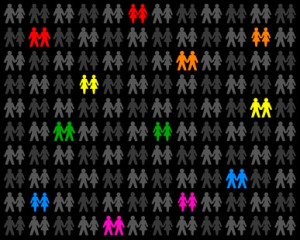Less than 3 percent of U.S. adults identified themselves as gay, lesbian or bisexual in a recent government survey, the first large-scale collection of statistics on sexual orientation.
When asked about the findings, members of the Association for Lesbian, Gay, Bisexual and  Transgender Issues in Counseling, a division of the American Counseling Association, indicated those numbers — while important to collect — are likely lower than the real figure.
Transgender Issues in Counseling, a division of the American Counseling Association, indicated those numbers — while important to collect — are likely lower than the real figure.
That could be for a variety of reasons, including that survey data was collected in part via face-to-face interviews, agreed ALGBTIC President Jane Rheineck and Mark Pope, a past president of both ALGBTIC and ACA.
“These [statistics] are substantially lower than I would expect, but understandable since many LGB (lesbian, gay and bisexual) people hide their sexual orientation and would be unlikely to disclose such information in a survey that also included face-to-face interviews and follow-up telephone calls,” says Pope, a professor of counseling at the University of Missouri-St. Louis. “As the question is asked more often in surveys, as we ask the question better and as our society grows more at ease with issues of sexual orientation, we will see such numbers become more accurate.”
Rheineck, an associate professor of counseling at Northern Illinois University, pointed out that there is still a great deal of stigma attached to homosexuality, especially in the context of reporting sexual orientation to a stranger administering a survey. It’s both a sensitive topic and a marginalized population, she says.
“There are two stigmas involved: one is illness/disease [regarding the survey’s questions on health], and the other is being lesbian, gay, bisexual or transgender,” says Rheineck. “Parts of society can be uncomfortable with both variables, which may then leave the individual feeling even more marginalized.”
The U.S. Centers for Disease Control and Prevention (CDC) surveyed close to 35,000 adults between the ages of 18 and 64 for its most recent National Health Interview Survey. Of the survey participants, 96.6 percent identified as straight, 1.6 percent identified as gay or lesbian and 0.7 percent identified as bisexual.
The remaining 1.1 percent identified as ‘‘something else,’’ chose ‘‘I don’t know the answer’’ or skipped the question.
This marked the first time that the CDC included questions about sexual orientation in its annual national health survey. The survey also collected data about general health issues, asking respondents if they had health insurance, had a “usual place” to receive medical care, had received a flu shot, smoked cigarettes or had been tested for HIV.
Although the government’s statistics on America’s non-straight population were lower than expected, Rheineck and Pope agree that the national survey represented a good start in collecting useful data on LGBT health issues, including mental health. Such information is used by governmental and private agencies for developing budgets, allocating funding and services.
“You have to start somewhere, so I’m pleased to see this,” Rheineck says.
The survey is also important because mental health and physical health issues, such as HIV/AIDS, anxiety and depression, are closely intertwined with the LGBT population, she says.
“It is critically important to ask these questions so that the government can have data that LGB people exist and are part of the U.S. population,” Pope says. “… With larger numbers of self-identified lesbians, gays or bisexuals, counseling programs are more likely to see this as an important issue and have a course or part of a course, such as a multicultural counseling course, dedicated to developing the knowledge, skills and awareness of working with this particular cultural group.”
Some takeaways from the survey:
- A higher percentage of adults who identified as gay, lesbian or bisexual had five or more drinks in one day in the past year and were current cigarette smokers than were adults who identified as straight
- A higher percentage of women than men identified as bisexual
- A lower percentage of adults age 65 and over identified as gay or lesbian (0.7 percent) or bisexual (0.2 percent) compared with adults between the ages of 18 and 44 (gay or lesbian: 1.9 percent; bisexual: 1.1 percent) and adults 45–64 (gay or lesbian: 1.8 percent; bisexual: 0.4 percent)
- When asked if they had “experienced serious psychological distress in past 30 days,” survey takers who identified as gay, lesbian or bisexual answered in the affirmative more than those who self-identified as straight
Other nongovernmental surveys have put estimates of the overall gay, lesbian and bisexual population at 3.5 to 4 percent of the total population.
****
For more information
PDF summary from the CDC, “Sexual Orientation and Health Among U.S. Adults: National Health Interview Survey, 2013”: cdc.gov/nchs/data/nhsr/nhsr077.pdf
Full survey data: cdc.gov/nchs/nhis/quest_data_related_1997_forward.htm
ALGBTIC website: algbtic.org
News coverage:
From the Washington Post, “Health survey gives government its first large-scale data on gay, bisexual population”: wapo.st/1rcVvBH
From USA Today, “Just over 2% tell CDC they are gay, lesbian, bisexual”: usat.ly/1mI1FH5
****
Bethany Bray is a staff writer for Counseling Today. Contact her at bbray@counseling.org
Follow Counseling Today on Twitter @ACA_CTonline and on Facebook: facebook.com/CounselingToday
